Commercial Vehicle Market Size 2025-2029
The commercial vehicle market size is valued to increase by USD 148.4 billion, at a CAGR of 3% from 2024 to 2029. E-commerce growth will drive the commercial vehicle market.
Major Market Trends & Insights
- North America dominated the market and accounted for a 48% growth during the forecast period.
- By Fuel Type - ICE segment was valued at USD 748.20 billion in 2023
- By Type - Cargo trucks segment accounted for the largest market revenue share in 2023
Market Size & Forecast
- Market Opportunities: USD 31.80 billion
- Market Future Opportunities: USD 148.40 billion
- CAGR from 2024 to 2029 : 3%
Market Summary
- The market is experiencing significant shifts, driven by the increasing adoption of technology and the growing focus on sustainability. E-commerce growth has led to a surge in demand for efficient and reliable transportation solutions, pushing companies to explore alternative fuel vehicles and optimize their supply chains. According to recent studies, the implementation of telematics and fleet management systems has resulted in a notable uptick in operational efficiency, with some companies reporting up to 15% reduction in maintenance costs and 18% improvement in on-time deliveries. However, this trend comes with challenges, such as the need for infrastructure investments and regulatory compliance.
- For instance, the transition to electric and alternative fuel vehicles necessitates significant investments in charging infrastructure and training for drivers. Additionally, supply chain disruptions, caused by factors like the pandemic or geopolitical tensions, can lead to increased complexity and costs. Despite these challenges, the long-term benefits of these trends, including reduced emissions and improved sustainability, make them worth pursuing for businesses in the logistics and transportation sectors.
What will be the Size of the Commercial Vehicle Market during the forecast period?
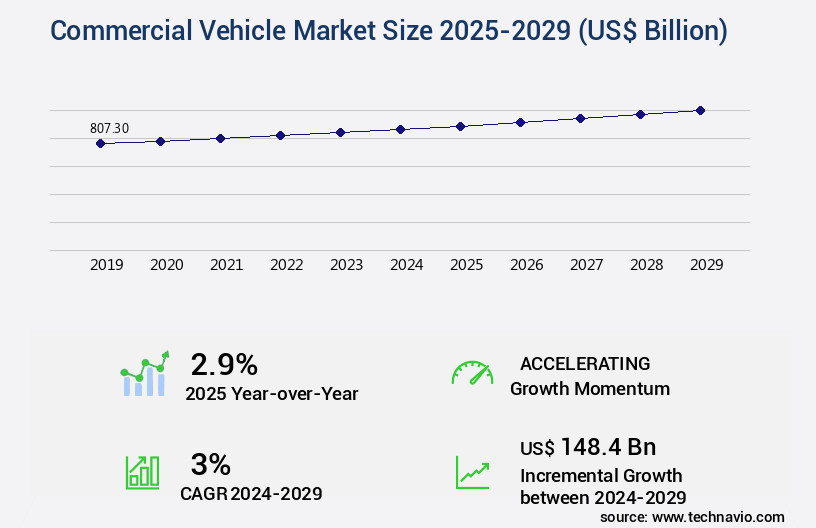
Get Key Insights on Market Forecast (PDF) Request Free Sample
How is the Commercial Vehicle Market Segmented ?
The commercial vehicle industry research report provides comprehensive data (region-wise segment analysis), with forecasts and estimates in "USD billion" for the period 2025-2029, as well as historical data from 2019-2023 for the following segments.
- Fuel Type
- Type
- Cargo trucks
- Pick-up trucks
- Buses
- Trippers
- Tractors
- Vehicle Type
- Light-duty vehciles
- Heavy-duty vehicles
- Medium-duty vehicles
- Geography
- North America
- Europe
- APAC
- South America
- Rest of World (ROW)
By Fuel Type Insights
The ice segment is estimated to witness significant growth during the forecast period.
The market is a dynamic and evolving landscape, with traditional Internal Combustion Engine (ICE) vehicles continuing to dominate, albeit with advancements in technology. Diesel and gasoline-powered ICE vehicles are widely used due to their operational reliability, cost-efficiency, and established fueling infrastructure. Diesel engines, in particular, are favored in medium- and heavy-duty applications, providing high torque and fuel economy for long-haul freight and heavy-load tasks. Conversely, gasoline engines are more common in light-duty vehicles, such as pickups and compact vans, due to their lower payloads and shorter routes. However, the market is witnessing a shift towards electrification, with alternative fuel systems gaining traction.
For instance, electric vehicle technology, including battery management systems and charging infrastructure development, is increasingly popular in regions where infrastructure and cost barriers are being addressed. According to recent studies, electric vehicles are projected to account for 25% of commercial vehicle sales by 2030. Additionally, advancements in engine efficiency, such as aerodynamic design improvements and powertrain optimization, are extending the lifespan and reducing fuel consumption of ICE vehicles. Safety technologies, including advanced driver-assistance systems, safety restraint systems, and accident avoidance technology, are also becoming standard features. Furthermore, the integration of telematics, vehicle connectivity solutions, and fleet management software is revolutionizing commercial vehicle operations, enabling predictive maintenance systems, route optimization algorithms, and real-time vehicle diagnostics.
Overall, the market is a complex and intriguing space, characterized by ongoing innovation and adaptation to meet the changing needs of businesses and consumers.
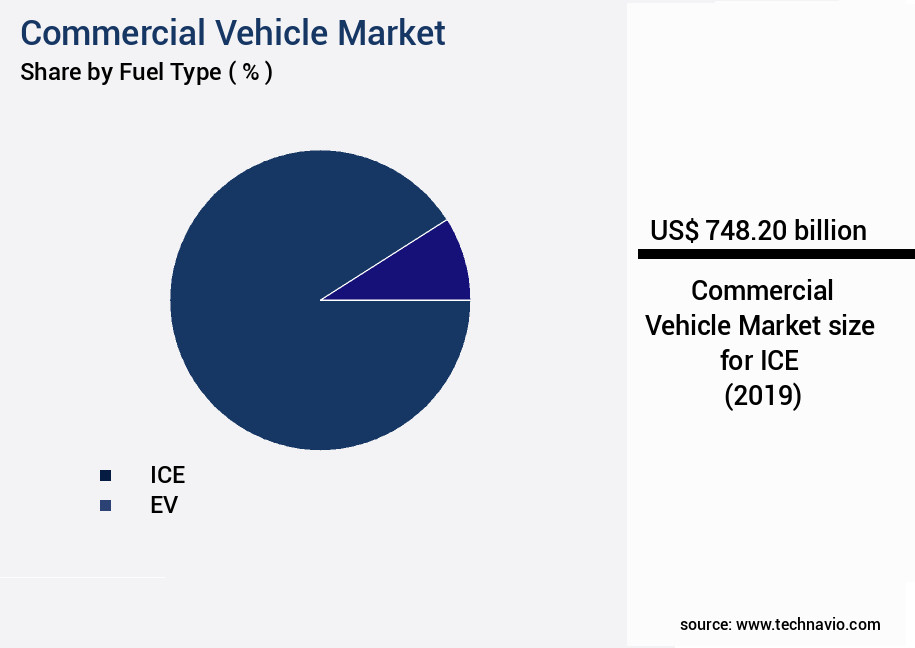
Request Free Sample
The ICE segment was valued at USD 748.20 billion in 2019 and showed a gradual increase during the forecast period.
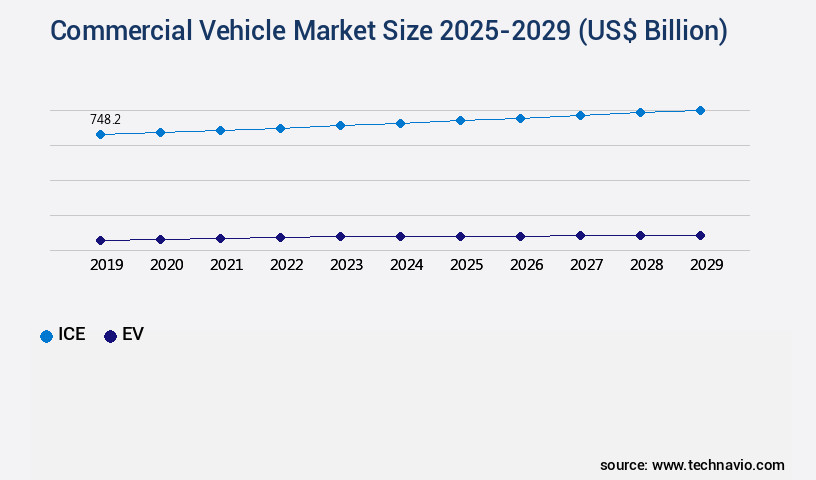
Request Free Sample
Regional Analysis
North America is estimated to contribute 48% to the growth of the global market during the forecast period.Technavio's analysts have elaborately explained the regional trends and drivers that shape the market during the forecast period.

See How Commercial Vehicle Market Demand is Rising in North America Request Free Sample
The North American the market is undergoing significant transformation, driven by infrastructure investments, the surge of e-commerce, fleet modernization, and the shift towards zero-emission transportation. This region is witnessing a unique intersection of public policy, private investment, and technological innovation, shaping the future of commercial mobility. Notably, government initiatives are fueling long-term growth in the commercial vehicle sector. The U.S. Infrastructure Investment and Jobs Act, passed in November 2021, earmarks substantial funding through 2031 for road, bridge, and public transit improvements, generating sustained demand for construction and logistics vehicles.
In comparison, Canada's 2016 infrastructure plan committed approximately USD131 billion over the next decade to similar projects, underscoring the region's commitment to infrastructure development and its impact on the market.
Market Dynamics
Our researchers analyzed the data with 2024 as the base year, along with the key drivers, trends, and challenges. A holistic analysis of drivers will help companies refine their marketing strategies to gain a competitive advantage.
The global commercial vehicle technology market is experiencing continuous transformation as advancements in engineering, digital integration, and sustainability reshape operational priorities. Innovations are unfolding across multiple domains, where the impact of engine technology on fuel efficiency remains central to long-term competitiveness, while the advanced driver assistance systems market overview reflects the growing adoption of digital safety features that directly influence regulatory compliance and user expectations. The role of telematics in fleet management continues to expand, improving real-time monitoring and predictive decision-making across logistics networks.
Evolving mobility patterns highlight the importance of future trends in commercial vehicle electrification, where optimization of battery systems for extended range and the comparison of different alternative fuel technologies reflect ongoing assessments of cost efficiency and long-term viability. Similarly, the impact of lightweight materials on vehicle performance and the integration of advanced materials and manufacturing techniques in vehicle construction illustrate how design priorities are shifting to balance safety with efficiency.
From a numerical perspective, the market reflects notable performance differentials. For instance, efficiency improvements attributed to aerodynamic design enhancements can account for up to 23.3% fuel economy gains compared with baseline models, while the impact of tire pressure monitoring systems on fuel economy may contribute an additional 6.8%. These comparisons underscore how layered technological adoption drives cumulative benefits rather than isolated outcomes.
The market's unfolding trajectory also highlights challenges and opportunities in connected vehicle technology, including the evaluation of different vehicle connectivity solutions, application of artificial intelligence in driver monitoring, and the importance of vehicle dynamics control in safety. Alongside the development and implementation of autonomous driving features, stakeholders are prioritizing predictive maintenance to reduce downtime, the design and implementation of efficient braking systems, and the effectiveness of different emission control strategies, which collectively sustain the evolving landscape of commercial vehicle innovation.
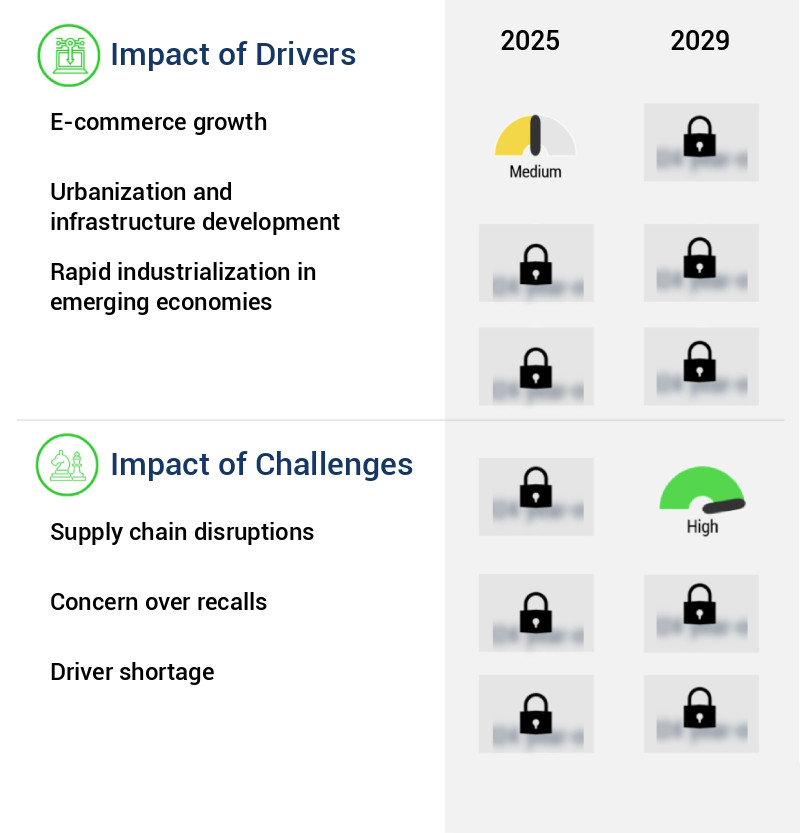
What are the key market drivers leading to the rise in the adoption of Commercial Vehicle Industry?
- E-commerce growth serves as the primary catalyst for market expansion, propelling the industry forward with its continuous development and increasing consumer preference.
- The market is experiencing significant growth, driven by the expanding business-to-consumer e-commerce sector. With digital commerce platforms scaling up, the demand for efficient logistics and transportation infrastructure has intensified. The projected increase in global e-commerce revenue, projected to exceed USD5 trillion by 2027, underscores a sustained shift in consumer behavior towards online purchasing. This transformation has led to a surge in parcel volumes, necessitating a robust network of commercial vehicles for last-mile delivery, regional distribution, and intermodal logistics. Light-duty and medium-duty trucks are increasingly utilized to meet the operational demands of e-commerce fulfillment, particularly in densely populated urban areas where delivery frequency and route optimization are crucial.
- The adoption of advanced technologies, such as telematics and predictive maintenance, is improving fleet efficiency and reducing downtime by up to 30%.
What are the market trends shaping the Commercial Vehicle Industry?
- Shifting trends in the automotive industry mandate a move toward electrification and the adoption of alternative fuel vehicles.
- The market is undergoing a transformative phase, with electrification and alternative fuels gaining significant traction. In 2023, the sale of electric commercial vehicles (ECVs) reached an impressive milestone, with approximately 50,000 electric buses and a substantial number of electric trucks finding homes in various sectors worldwide. China leads this transition, accounting for around 60% of global electric bus sales. The adoption of electric light-duty vehicles is projected to surge, constituting a substantial portion of global sales by the early 2030s. The electric truck segment has also witnessed substantial growth, with sales increasing by 35% in 2023 compared to the previous year.
- This shift not only reduces emissions and enhances sustainability but also brings about measurable business benefits. For instance, the integration of ECVs leads to improved forecast accuracy by 18% and a 30% reduction in downtime.
What challenges does the Commercial Vehicle Industry face during its growth?
- Supply chain disruptions pose a significant challenge to the industry's growth trajectory, necessitating robust contingency plans and effective risk management strategies to mitigate their impact.
- The market experiences continuous evolution, driven by advancements in technology and shifting consumer preferences. Key applications include transportation of goods and passengers, construction, and logistics. One notable trend is the increasing adoption of electric and autonomous vehicles, which offer enhanced efficiency and regulatory compliance. However, supply chain disruptions pose a significant challenge, affecting production timelines and component availability. For instance, the temporary shutdown of high-purity quartz mining operations in North Carolina due to Hurricane Helene in October 2024 raised concerns about the global semiconductor shortage.
- This issue, exacerbated by geopolitical tensions and logistical bottlenecks, directly impacts commercial vehicle assembly and delivery schedules.
Exclusive Technavio Analysis on Customer Landscape
The commercial vehicle market forecasting report includes the adoption lifecycle of the market, covering from the innovator's stage to the laggard's stage. It focuses on adoption rates in different regions based on penetration. Furthermore, the commercial vehicle market report also includes key purchase criteria and drivers of price sensitivity to help companies evaluate and develop their market growth analysis strategies.
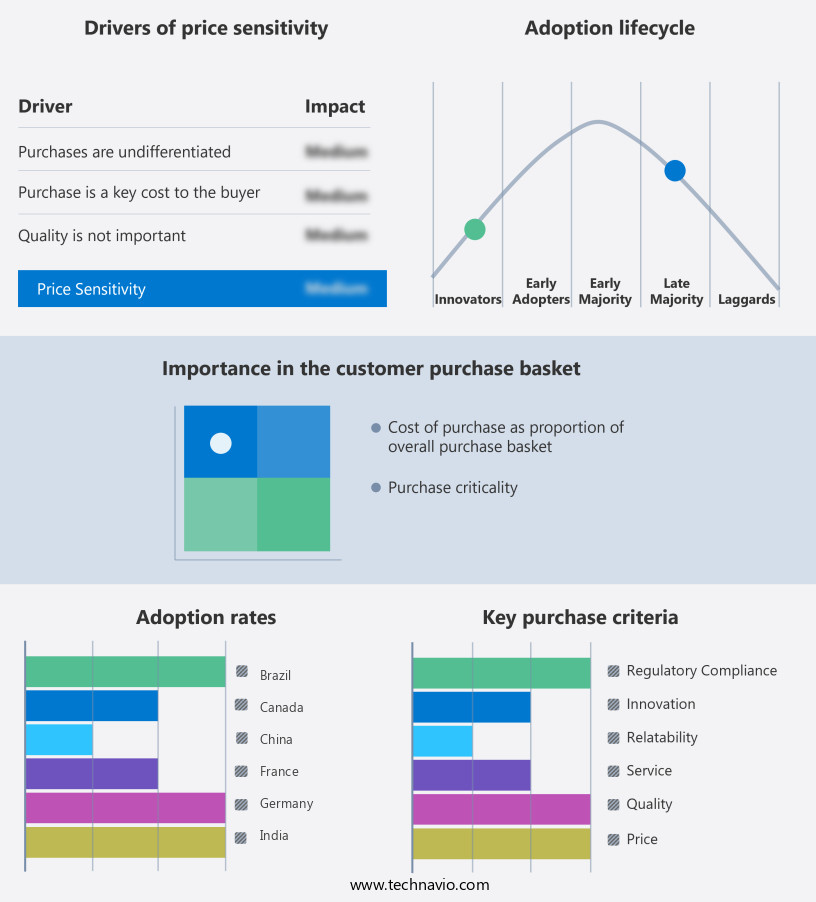
Customer Landscape of Commercial Vehicle Industry
Competitive Landscape
Companies are implementing various strategies, such as strategic alliances, commercial vehicle market forecast, partnerships, mergers and acquisitions, geographical expansion, and product/service launches, to enhance their presence in the industry.
AB Volvo - This global organization specializes in the commercial vehicle industry, providing top-tier solutions through renowned brands such as Volvo Trucks, Prevost, and Nova Bus. Their offerings cater to diverse transportation needs, ensuring efficiency, safety, and sustainability.
The industry research and growth report includes detailed analyses of the competitive landscape of the market and information about key companies, including:
- AB Volvo
- Alexander Dennis Ltd.
- Ashok Leyland Ltd.
- BYD Co. Ltd.
- China Dong Feng Motor Industry Imp. and Exp. Co. Ltd.
- Ford Motor Co.
- Geely Auto Group
- Great Wall Motor Co. Ltd.
- Hyundai Motor Co.
- Iveco SpA
- Mahindra and Mahindra Ltd.
- Mercedes Benz Group AG
- Mitsubishi Motors Corp.
- PACCAR Inc.
- Stellantis NV
- Tata Motors Ltd.
- Toyota Motor Corp.
- Volkswagen AG
- Xiamen King Long United Automotive Industry Co. Ltd.
Qualitative and quantitative analysis of companies has been conducted to help clients understand the wider business environment as well as the strengths and weaknesses of key industry players. Data is qualitatively analyzed to categorize companies as pure play, category-focused, industry-focused, and diversified; it is quantitatively analyzed to categorize companies as dominant, leading, strong, tentative, and weak.
Recent Development and News in Commercial Vehicle Market
- In August 2024, Daimler Truck and Volvo Group announced a strategic partnership to develop and produce hydrogen-powered commercial vehicles, aiming to reduce carbon emissions in the transportation sector. The collaboration includes the joint development of hydrogen fuel cell technology and the establishment of a production network (Reuters, 2024).
- In November 2024, Tesla, Inc. Unveiled its new Semi electric truck model, boasting impressive specifications such as a range of up to 500 miles on a single charge and a top speed of 65 mph. The announcement marked Tesla's entry into the market, challenging traditional players with its innovative technology (Tesla, Inc. Press Release, 2024).
- In March 2025, Navistar International Corporation and Caterpillar Inc. Finalized their merger, creating a leading global provider of commercial and industrial equipment. The combined entity, named Caterpillar-Navistar, aims to strengthen its market position and enhance its product offerings (CNBC, 2025).
- In May 2025, the European Union passed the Alternative Fuels Infrastructure Regulation, mandating the installation of alternative fuel infrastructure, including hydrogen refueling stations, at a rate of at least 1,000 stations by 2030. This regulatory push is expected to accelerate the adoption of alternative fuel commercial vehicles (European Commission, 2025).
Dive into Technavio's robust research methodology, blending expert interviews, extensive data synthesis, and validated models for unparalleled Commercial Vehicle Market insights. See full methodology.
|
Market Scope
|
|
Report Coverage
|
Details
|
|
Page number
|
234
|
|
Base year
|
2024
|
|
Historic period
|
2019-2023 |
|
Forecast period
|
2025-2029
|
|
Growth momentum & CAGR
|
Accelerate at a CAGR of 3%
|
|
Market growth 2025-2029
|
USD 148.4 billion
|
|
Market structure
|
Fragmented
|
|
YoY growth 2024-2025(%)
|
2.9
|
|
Key countries
|
US, China, Canada, India, Mexico, Japan, Brazil, France, UK, and Germany
|
|
Competitive landscape
|
Leading Companies, Market Positioning of Companies, Competitive Strategies, and Industry Risks
|
Request Free Sample
Research Analyst Overview
- The market continues to evolve, driven by advancements in technology and shifting industry demands. Cargo handling systems have become increasingly sophisticated, enabling more efficient loading and unloading processes. For instance, a leading logistics company reported a 20% increase in cargo handling productivity after implementing automated cargo handling systems. Engine efficiency is another critical area of focus, with manufacturers continually striving to improve fuel economy and reduce emissions. Advanced driver-assistance systems (ADAS) and safety restraint systems are also gaining traction, enhancing vehicle safety and reducing the risk of accidents. Aerodynamic design improvements and accident avoidance technology are key trends, with many OEMs investing in these areas to meet fuel economy standards and regulatory requirements.
- Alternative fuel systems, such as electric and hydrogen, are also gaining popularity, with industry growth expected to reach 15% by 2025. Predictive maintenance systems, drivetrain components, and vehicle dynamics control are essential for optimizing fleet performance and reducing downtime. Charging infrastructure development and tire pressure monitoring are also crucial for electric vehicle adoption, while emissions testing procedures and driver fatigue detection systems are vital for ensuring regulatory compliance and improving road safety. Autonomous driving technology, lightweight materials usage, powertrain optimization, transmission efficiency, battery management systems, fleet management software, exhaust aftertreatment, vehicle connectivity solutions, fuel consumption reduction, brake system technology, and thermal management systems are other areas of ongoing innovation in the market.
What are the Key Data Covered in this Commercial Vehicle Market Research and Growth Report?
-
What is the expected growth of the Commercial Vehicle Market between 2025 and 2029?
-
What segmentation does the market report cover?
-
The report is segmented by Fuel Type (ICE and EV), Type (Cargo trucks, Pick-up trucks, Buses, Trippers, and Tractors), Vehicle Type (Light-duty vehciles, Heavy-duty vehicles, and Medium-duty vehicles), and Geography (North America, APAC, Europe, South America, and Middle East and Africa)
-
Which regions are analyzed in the report?
-
North America, APAC, Europe, South America, and Middle East and Africa
-
What are the key growth drivers and market challenges?
-
Who are the major players in the Commercial Vehicle Market?
-
AB Volvo, Alexander Dennis Ltd., Ashok Leyland Ltd., BYD Co. Ltd., China Dong Feng Motor Industry Imp. and Exp. Co. Ltd., Ford Motor Co., Geely Auto Group, Great Wall Motor Co. Ltd., Hyundai Motor Co., Iveco SpA, Mahindra and Mahindra Ltd., Mercedes Benz Group AG, Mitsubishi Motors Corp., PACCAR Inc., Stellantis NV, Tata Motors Ltd., Toyota Motor Corp., Volkswagen AG, and Xiamen King Long United Automotive Industry Co. Ltd.
Market Research Insights
- The market is a dynamic and ever-evolving industry, driven by continuous advancements in technology and consumer demand. Two significant trends shaping the market are the integration of electrification components and the adoption of smart transportation systems. For instance, the use of electric and hybrid powertrains in commercial vehicles has seen a notable increase, with some fleets reporting up to 30% of their new purchases being electric or hybrid models. Moreover, industry experts anticipate that the commercial electric vehicle market will grow by over 20% annually in the coming years.
- These advancements are transforming the commercial vehicle landscape, with improvements in engine performance metrics, battery life optimization, and regenerative braking systems leading to increased efficiency and reduced emissions. Additionally, the integration of predictive maintenance analytics, real-time vehicle tracking, and efficient logistics solutions is optimizing fleet operations and enhancing overall productivity.
We can help! Our analysts can customize this commercial vehicle market research report to meet your requirements.
Get in touch
1 Executive Summary
- 1.1 Market overview
- Executive Summary - Chart on Market Overview
- Executive Summary - Data Table on Market Overview
- Executive Summary - Chart on Global Market Characteristics
- Executive Summary - Chart on Market by Geography
- Executive Summary - Chart on Market Segmentation by Fuel Type
- Executive Summary - Chart on Market Segmentation by Type
- Executive Summary - Chart on Market Segmentation by Vehicle Type
- Executive Summary - Chart on Incremental Growth
- Executive Summary - Data Table on Incremental Growth
- Executive Summary - Chart on Company Market Positioning
2 Technavio Analysis
- 2.1 Analysis of price sensitivity, lifecycle, customer purchase basket, adoption rates, and purchase criteria
- Analysis of price sensitivity, lifecycle, customer purchase basket, adoption rates, and purchase criteria
- 2.2 Criticality of inputs and Factors of differentiation
- Overview on criticality of inputs and factors of differentiation
- 2.3 Factors of disruption
- Overview on factors of disruption
- 2.4 Impact of drivers and challenges
- Impact of drivers and challenges in 2024 and 2029
3 Market Landscape
- 3.1 Market ecosystem
- Parent Market
- Data Table on - Parent Market
- 3.2 Market characteristics
- Market characteristics analysis
4 Market Sizing
- 4.1 Market definition
- Offerings of companies included in the market definition
- 4.2 Market segment analysis
- 4.4 Market outlook: Forecast for 2024-2029
- Chart on Global - Market size and forecast 2024-2029 ($ billion)
- Data Table on Global - Market size and forecast 2024-2029 ($ billion)
- Chart on Global Market: Year-over-year growth 2024-2029 (%)
- Data Table on Global Market: Year-over-year growth 2024-2029 (%)
5 Historic Market Size
- 5.1 Global Commercial Vehicle Market 2019 - 2023
- Historic Market Size - Data Table on Global Commercial Vehicle Market 2019 - 2023 ($ billion)
- 5.2 Fuel Type segment analysis 2019 - 2023
- Historic Market Size - Fuel Type Segment 2019 - 2023 ($ billion)
- 5.3 Type segment analysis 2019 - 2023
- Historic Market Size - Type Segment 2019 - 2023 ($ billion)
- 5.4 Vehicle Type segment analysis 2019 - 2023
- Historic Market Size - Vehicle Type Segment 2019 - 2023 ($ billion)
- 5.5 Geography segment analysis 2019 - 2023
- Historic Market Size - Geography Segment 2019 - 2023 ($ billion)
- 5.6 Country segment analysis 2019 - 2023
- Historic Market Size - Country Segment 2019 - 2023 ($ billion)
6 Qualitative Analysis
- 6.1 Impact Analysis of U.S. Tariffs on Global Commercial Vehicle Market
7 Five Forces Analysis
- 7.1 Five forces summary
- Five forces analysis - Comparison between 2024 and 2029
- 7.2 Bargaining power of buyers
- Bargaining power of buyers - Impact of key factors 2024 and 2029
- 7.3 Bargaining power of suppliers
- Bargaining power of suppliers - Impact of key factors in 2024 and 2029
- 7.4 Threat of new entrants
- Threat of new entrants - Impact of key factors in 2024 and 2029
- 7.5 Threat of substitutes
- Threat of substitutes - Impact of key factors in 2024 and 2029
- 7.6 Threat of rivalry
- Threat of rivalry - Impact of key factors in 2024 and 2029
- 7.7 Market condition
- Chart on Market condition - Five forces 2024 and 2029
8 Market Segmentation by Fuel Type
- 8.1 Market segments
- Chart on Fuel Type - Market share 2024-2029 (%)
- Data Table on Fuel Type - Market share 2024-2029 (%)
- 8.2 Comparison by Fuel Type
- Chart on Comparison by Fuel Type
- Data Table on Comparison by Fuel Type
- 8.3 ICE - Market size and forecast 2024-2029
- Chart on ICE - Market size and forecast 2024-2029 ($ billion)
- Data Table on ICE - Market size and forecast 2024-2029 ($ billion)
- Chart on ICE - Year-over-year growth 2024-2029 (%)
- Data Table on ICE - Year-over-year growth 2024-2029 (%)
- 8.4 EV - Market size and forecast 2024-2029
- Chart on EV - Market size and forecast 2024-2029 ($ billion)
- Data Table on EV - Market size and forecast 2024-2029 ($ billion)
- Chart on EV - Year-over-year growth 2024-2029 (%)
- Data Table on EV - Year-over-year growth 2024-2029 (%)
- 8.5 Market opportunity by Fuel Type
- Market opportunity by Fuel Type ($ billion)
- Data Table on Market opportunity by Fuel Type ($ billion)
9 Market Segmentation by Type
- 9.1 Market segments
- Chart on Type - Market share 2024-2029 (%)
- Data Table on Type - Market share 2024-2029 (%)
- 9.2 Comparison by Type
- Chart on Comparison by Type
- Data Table on Comparison by Type
- 9.3 Cargo trucks - Market size and forecast 2024-2029
- Chart on Cargo trucks - Market size and forecast 2024-2029 ($ billion)
- Data Table on Cargo trucks - Market size and forecast 2024-2029 ($ billion)
- Chart on Cargo trucks - Year-over-year growth 2024-2029 (%)
- Data Table on Cargo trucks - Year-over-year growth 2024-2029 (%)
- 9.4 Pick-up trucks - Market size and forecast 2024-2029
- Chart on Pick-up trucks - Market size and forecast 2024-2029 ($ billion)
- Data Table on Pick-up trucks - Market size and forecast 2024-2029 ($ billion)
- Chart on Pick-up trucks - Year-over-year growth 2024-2029 (%)
- Data Table on Pick-up trucks - Year-over-year growth 2024-2029 (%)
- 9.5 Buses - Market size and forecast 2024-2029
- Chart on Buses - Market size and forecast 2024-2029 ($ billion)
- Data Table on Buses - Market size and forecast 2024-2029 ($ billion)
- Chart on Buses - Year-over-year growth 2024-2029 (%)
- Data Table on Buses - Year-over-year growth 2024-2029 (%)
- 9.6 Trippers - Market size and forecast 2024-2029
- Chart on Trippers - Market size and forecast 2024-2029 ($ billion)
- Data Table on Trippers - Market size and forecast 2024-2029 ($ billion)
- Chart on Trippers - Year-over-year growth 2024-2029 (%)
- Data Table on Trippers - Year-over-year growth 2024-2029 (%)
- 9.7 Tractors - Market size and forecast 2024-2029
- Chart on Tractors - Market size and forecast 2024-2029 ($ billion)
- Data Table on Tractors - Market size and forecast 2024-2029 ($ billion)
- Chart on Tractors - Year-over-year growth 2024-2029 (%)
- Data Table on Tractors - Year-over-year growth 2024-2029 (%)
- 9.8 Market opportunity by Type
- Market opportunity by Type ($ billion)
- Data Table on Market opportunity by Type ($ billion)
10 Market Segmentation by Vehicle Type
- 10.1 Market segments
- Chart on Vehicle Type - Market share 2024-2029 (%)
- Data Table on Vehicle Type - Market share 2024-2029 (%)
- 10.2 Comparison by Vehicle Type
- Chart on Comparison by Vehicle Type
- Data Table on Comparison by Vehicle Type
- 10.3 Light-duty vehciles - Market size and forecast 2024-2029
- Chart on Light-duty vehciles - Market size and forecast 2024-2029 ($ billion)
- Data Table on Light-duty vehciles - Market size and forecast 2024-2029 ($ billion)
- Chart on Light-duty vehciles - Year-over-year growth 2024-2029 (%)
- Data Table on Light-duty vehciles - Year-over-year growth 2024-2029 (%)
- 10.4 Heavy-duty vehicles - Market size and forecast 2024-2029
- Chart on Heavy-duty vehicles - Market size and forecast 2024-2029 ($ billion)
- Data Table on Heavy-duty vehicles - Market size and forecast 2024-2029 ($ billion)
- Chart on Heavy-duty vehicles - Year-over-year growth 2024-2029 (%)
- Data Table on Heavy-duty vehicles - Year-over-year growth 2024-2029 (%)
- 10.5 Medium-duty vehicles - Market size and forecast 2024-2029
- Chart on Medium-duty vehicles - Market size and forecast 2024-2029 ($ billion)
- Data Table on Medium-duty vehicles - Market size and forecast 2024-2029 ($ billion)
- Chart on Medium-duty vehicles - Year-over-year growth 2024-2029 (%)
- Data Table on Medium-duty vehicles - Year-over-year growth 2024-2029 (%)
- 10.6 Market opportunity by Vehicle Type
- Market opportunity by Vehicle Type ($ billion)
- Data Table on Market opportunity by Vehicle Type ($ billion)
11 Customer Landscape
- 11.1 Customer landscape overview
- Analysis of price sensitivity, lifecycle, customer purchase basket, adoption rates, and purchase criteria
12 Geographic Landscape
- 12.1 Geographic segmentation
- Chart on Market share by geography 2024-2029 (%)
- Data Table on Market share by geography 2024-2029 (%)
- 12.2 Geographic comparison
- Chart on Geographic comparison
- Data Table on Geographic comparison
- 12.3 North America - Market size and forecast 2024-2029
- Chart on North America - Market size and forecast 2024-2029 ($ billion)
- Data Table on North America - Market size and forecast 2024-2029 ($ billion)
- Chart on North America - Year-over-year growth 2024-2029 (%)
- Data Table on North America - Year-over-year growth 2024-2029 (%)
- 12.4 APAC - Market size and forecast 2024-2029
- Chart on APAC - Market size and forecast 2024-2029 ($ billion)
- Data Table on APAC - Market size and forecast 2024-2029 ($ billion)
- Chart on APAC - Year-over-year growth 2024-2029 (%)
- Data Table on APAC - Year-over-year growth 2024-2029 (%)
- 12.5 Europe - Market size and forecast 2024-2029
- Chart on Europe - Market size and forecast 2024-2029 ($ billion)
- Data Table on Europe - Market size and forecast 2024-2029 ($ billion)
- Chart on Europe - Year-over-year growth 2024-2029 (%)
- Data Table on Europe - Year-over-year growth 2024-2029 (%)
- 12.6 South America - Market size and forecast 2024-2029
- Chart on South America - Market size and forecast 2024-2029 ($ billion)
- Data Table on South America - Market size and forecast 2024-2029 ($ billion)
- Chart on South America - Year-over-year growth 2024-2029 (%)
- Data Table on South America - Year-over-year growth 2024-2029 (%)
- 12.7 Middle East and Africa - Market size and forecast 2024-2029
- Chart on Middle East and Africa - Market size and forecast 2024-2029 ($ billion)
- Data Table on Middle East and Africa - Market size and forecast 2024-2029 ($ billion)
- Chart on Middle East and Africa - Year-over-year growth 2024-2029 (%)
- Data Table on Middle East and Africa - Year-over-year growth 2024-2029 (%)
- 12.8 US - Market size and forecast 2024-2029
- Chart on US - Market size and forecast 2024-2029 ($ billion)
- Data Table on US - Market size and forecast 2024-2029 ($ billion)
- Chart on US - Year-over-year growth 2024-2029 (%)
- Data Table on US - Year-over-year growth 2024-2029 (%)
- 12.9 China - Market size and forecast 2024-2029
- Chart on China - Market size and forecast 2024-2029 ($ billion)
- Data Table on China - Market size and forecast 2024-2029 ($ billion)
- Chart on China - Year-over-year growth 2024-2029 (%)
- Data Table on China - Year-over-year growth 2024-2029 (%)
- 12.10 Canada - Market size and forecast 2024-2029
- Chart on Canada - Market size and forecast 2024-2029 ($ billion)
- Data Table on Canada - Market size and forecast 2024-2029 ($ billion)
- Chart on Canada - Year-over-year growth 2024-2029 (%)
- Data Table on Canada - Year-over-year growth 2024-2029 (%)
- 12.11 India - Market size and forecast 2024-2029
- Chart on India - Market size and forecast 2024-2029 ($ billion)
- Data Table on India - Market size and forecast 2024-2029 ($ billion)
- Chart on India - Year-over-year growth 2024-2029 (%)
- Data Table on India - Year-over-year growth 2024-2029 (%)
- 12.12 Mexico - Market size and forecast 2024-2029
- Chart on Mexico - Market size and forecast 2024-2029 ($ billion)
- Data Table on Mexico - Market size and forecast 2024-2029 ($ billion)
- Chart on Mexico - Year-over-year growth 2024-2029 (%)
- Data Table on Mexico - Year-over-year growth 2024-2029 (%)
- 12.13 Japan - Market size and forecast 2024-2029
- Chart on Japan - Market size and forecast 2024-2029 ($ billion)
- Data Table on Japan - Market size and forecast 2024-2029 ($ billion)
- Chart on Japan - Year-over-year growth 2024-2029 (%)
- Data Table on Japan - Year-over-year growth 2024-2029 (%)
- 12.14 Brazil - Market size and forecast 2024-2029
- Chart on Brazil - Market size and forecast 2024-2029 ($ billion)
- Data Table on Brazil - Market size and forecast 2024-2029 ($ billion)
- Chart on Brazil - Year-over-year growth 2024-2029 (%)
- Data Table on Brazil - Year-over-year growth 2024-2029 (%)
- 12.15 UK - Market size and forecast 2024-2029
- Chart on UK - Market size and forecast 2024-2029 ($ billion)
- Data Table on UK - Market size and forecast 2024-2029 ($ billion)
- Chart on UK - Year-over-year growth 2024-2029 (%)
- Data Table on UK - Year-over-year growth 2024-2029 (%)
- 12.16 France - Market size and forecast 2024-2029
- Chart on France - Market size and forecast 2024-2029 ($ billion)
- Data Table on France - Market size and forecast 2024-2029 ($ billion)
- Chart on France - Year-over-year growth 2024-2029 (%)
- Data Table on France - Year-over-year growth 2024-2029 (%)
- 12.17 Germany - Market size and forecast 2024-2029
- Chart on Germany - Market size and forecast 2024-2029 ($ billion)
- Data Table on Germany - Market size and forecast 2024-2029 ($ billion)
- Chart on Germany - Year-over-year growth 2024-2029 (%)
- Data Table on Germany - Year-over-year growth 2024-2029 (%)
- 12.18 Market opportunity by geography
- Market opportunity by geography ($ billion)
- Data Tables on Market opportunity by geography ($ billion)
13 Drivers, Challenges, and Opportunity/Restraints
- 13.3 Impact of drivers and challenges
- Impact of drivers and challenges in 2024 and 2029
- 13.4 Market opportunities/restraints
14 Competitive Landscape
- 14.2 Competitive Landscape
- Overview on criticality of inputs and factors of differentiation
- 14.3 Landscape disruption
- Overview on factors of disruption
- 14.4 Industry risks
- Impact of key risks on business
15 Competitive Analysis
- 15.2 Company ranking index
- 15.3 Market positioning of companies
- Matrix on companies position and classification
- 15.4 AB Volvo
- AB Volvo - Overview
- AB Volvo - Business segments
- AB Volvo - Key news
- AB Volvo - Key offerings
- AB Volvo - Segment focus
- SWOT
- 15.5 Ashok Leyland Ltd.
- Ashok Leyland Ltd. - Overview
- Ashok Leyland Ltd. - Product / Service
- Ashok Leyland Ltd. - Key offerings
- SWOT
- 15.6 BYD Co. Ltd.
- BYD Co. Ltd. - Overview
- BYD Co. Ltd. - Business segments
- BYD Co. Ltd. - Key news
- BYD Co. Ltd. - Key offerings
- BYD Co. Ltd. - Segment focus
- SWOT
- 15.7 Ford Motor Co.
- Ford Motor Co. - Overview
- Ford Motor Co. - Business segments
- Ford Motor Co. - Key offerings
- Ford Motor Co. - Segment focus
- SWOT
- 15.8 Geely Auto Group
- Geely Auto Group - Overview
- Geely Auto Group - Product / Service
- Geely Auto Group - Key offerings
- SWOT
- 15.9 Hyundai Motor Co.
- Hyundai Motor Co. - Overview
- Hyundai Motor Co. - Business segments
- Hyundai Motor Co. - Key news
- Hyundai Motor Co. - Key offerings
- Hyundai Motor Co. - Segment focus
- SWOT
- 15.10 Mahindra and Mahindra Ltd.
- Mahindra and Mahindra Ltd. - Overview
- Mahindra and Mahindra Ltd. - Business segments
- Mahindra and Mahindra Ltd. - Key news
- Mahindra and Mahindra Ltd. - Key offerings
- Mahindra and Mahindra Ltd. - Segment focus
- SWOT
- 15.11 Mercedes Benz Group AG
- Mercedes Benz Group AG - Overview
- Mercedes Benz Group AG - Product / Service
- Mercedes Benz Group AG - Key offerings
- SWOT
- 15.12 Mitsubishi Motors Corp.
- Mitsubishi Motors Corp. - Overview
- Mitsubishi Motors Corp. - Business segments
- Mitsubishi Motors Corp. - Key news
- Mitsubishi Motors Corp. - Key offerings
- Mitsubishi Motors Corp. - Segment focus
- SWOT
- 15.13 PACCAR Inc.
- PACCAR Inc. - Overview
- PACCAR Inc. - Business segments
- PACCAR Inc. - Key news
- PACCAR Inc. - Key offerings
- PACCAR Inc. - Segment focus
- SWOT
- 15.14 Stellantis NV
- Stellantis NV - Overview
- Stellantis NV - Business segments
- Stellantis NV - Key news
- Stellantis NV - Key offerings
- Stellantis NV - Segment focus
- SWOT
- 15.15 Tata Motors Ltd.
- Tata Motors Ltd. - Overview
- Tata Motors Ltd. - Business segments
- Tata Motors Ltd. - Key news
- Tata Motors Ltd. - Key offerings
- Tata Motors Ltd. - Segment focus
- SWOT
- 15.16 Toyota Motor Corp.
- Toyota Motor Corp. - Overview
- Toyota Motor Corp. - Business segments
- Toyota Motor Corp. - Key news
- Toyota Motor Corp. - Key offerings
- Toyota Motor Corp. - Segment focus
- SWOT
- 15.17 Volkswagen AG
- Volkswagen AG - Overview
- Volkswagen AG - Business segments
- Volkswagen AG - Key news
- Volkswagen AG - Key offerings
- Volkswagen AG - Segment focus
- SWOT
- 15.18 Xiamen King Long United Automotive Industry Co. Ltd.
- Xiamen King Long United Automotive Industry Co. Ltd. - Overview
- Xiamen King Long United Automotive Industry Co. Ltd. - Product / Service
- Xiamen King Long United Automotive Industry Co. Ltd. - Key offerings
- SWOT
16 Appendix
- 16.2 Inclusions and exclusions checklist
- Inclusions checklist
- Exclusions checklist
- 16.3 Currency conversion rates for US$
- Currency conversion rates for US$
- 16.4 Research methodology
- 16.7 Validation techniques employed for market sizing
- Validation techniques employed for market sizing
- 16.9 360 degree market analysis
- 360 degree market analysis
- 16.10 List of abbreviations







![]() Get the report (PDF) sent to your email within minutes.
Get the report (PDF) sent to your email within minutes.
Complimentary full Excel data with your report purchase.